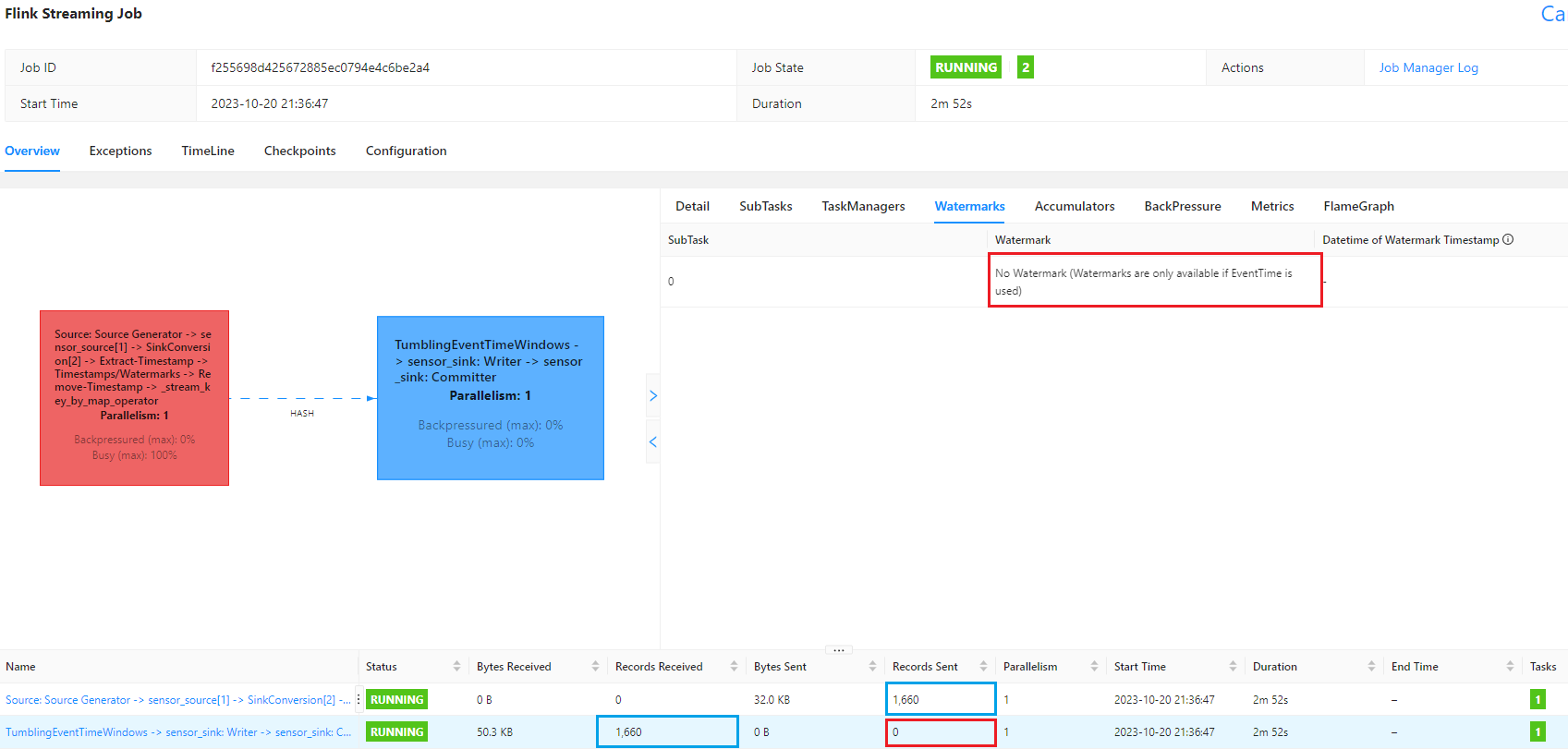Kafka 使用Flink对数据进行聚合后未发送到Kafka主题
问题描述
我正在进行一个简单的数据聚合示例。它只是按记录ID进行分组,并在1秒的滚动窗口上计算平均值。
- 使用Flink Faker连接器和Table api生成源数据,
- 将其转换为数据流,并分配时间戳和水印
- 执行一个用于聚合的处理窗口函数,并
- 将其发送到Kafka主题。
它在步骤3之前运行正常,但记录未发送到Kafka主题。这可能与水印分配有关吗?
请告诉我如何修复它?附上了作业状态的屏幕截图和源代码。

Pyflink app
import os
import time
from typing import Iterable, Tuple
from pyflink.common import Row, WatermarkStrategy
from pyflink.common.typeinfo import Types
from pyflink.common.watermark_strategy import TimestampAssigner
from pyflink.datastream import DataStream
from pyflink.datastream import StreamExecutionEnvironment, RuntimeExecutionMode
from pyflink.datastream.window import TumblingEventTimeWindows, Time
from pyflink.datastream.functions import ProcessWindowFunction
from pyflink.table import StreamTableEnvironment
from pyflink.datastream.connectors.kafka import (
KafkaSink,
KafkaRecordSerializationSchema,
DeliveryGuarantee,
)
from pyflink.datastream.formats.json import JsonRowSerializationSchema
from models import SensorReading
RUNTIME_ENV = os.getenv("RUNTIME_ENV", "local")
BOOTSTRAP_SERVERS = os.getenv("BOOTSTRAP_SERVERS", "localhost:29092")
class AggreteProcessWindowFunction(ProcessWindowFunction):
def process(
self, key: str, context: ProcessWindowFunction.Context, elements: Iterable[Tuple[int, int]]
) -> Iterable[Row]:
id, count, temperature = SensorReading.process_elements(elements)
yield Row(
id=id,
timestamp=int(context.window().end),
temperature=round(temperature / count, 2),
)
def define_workflow(source_stream: DataStream):
sensor_stream = (
source_stream.key_by(lambda e: e[0])
.window(TumblingEventTimeWindows.of(Time.seconds(1)))
.process(AggreteProcessWindowFunction(), output_type=SensorReading.get_value_type())
)
return sensor_stream
if __name__ == "__main__":
"""
## local execution
python src/c01_sensor_reading.py
## cluster execution
docker exec jobmanager /opt/flink/bin/flink run \
--python /tmp/src/c01_sensor_reading.py \
--pyFiles file:///tmp/src/models.py \
-d
"""
env = StreamExecutionEnvironment.get_execution_environment()
env.set_runtime_mode(RuntimeExecutionMode.STREAMING)
if RUNTIME_ENV == "local":
CURRENT_DIR = os.path.dirname(os.path.realpath(__file__))
jar_files = ["flink-faker-0.5.3.jar", "flink-sql-connector-kafka-1.17.1.jar"]
jar_paths = tuple(
[f"file://{os.path.join(CURRENT_DIR, 'jars', name)}" for name in jar_files]
)
print(jar_paths)
env.add_jars(*jar_paths)
t_env = StreamTableEnvironment.create(stream_execution_environment=env)
t_env.execute_sql(
"""
CREATE TABLE sensor_source (
`id` INT,
`rand` INT
)
WITH (
'connector' = 'faker',
'rows-per-second' = '10',
'fields.id.expression' = '#{number.numberBetween ''0'',''20''}',
'fields.rand.expression' = '#{number.numberBetween ''0'',''100''}'
);
"""
)
class DefaultTimestampAssigner(TimestampAssigner):
def extract_timestamp(self, value, record_timestamp):
return int(time.time_ns() / 1000000)
source_stream = t_env.to_append_stream(
t_env.from_path("sensor_source"), Types.TUPLE([Types.INT(), Types.INT()])
).assign_timestamps_and_watermarks(
WatermarkStrategy.for_monotonous_timestamps().with_timestamp_assigner(
DefaultTimestampAssigner()
)
)
sensor_sink = (
KafkaSink.builder()
.set_bootstrap_servers(BOOTSTRAP_SERVERS)
.set_record_serializer(
KafkaRecordSerializationSchema.builder()
.set_topic("sensor-reading")
.set_key_serialization_schema(
JsonRowSerializationSchema.builder()
.with_type_info(SensorReading.get_key_type())
.build()
)
.set_value_serialization_schema(
JsonRowSerializationSchema.builder()
.with_type_info(SensorReading.get_value_type())
.build()
)
.build()
)
.set_delivery_guarantee(DeliveryGuarantee.AT_LEAST_ONCE)
.build()
)
# define_workflow(source_stream).print() # it works!
define_workflow(source_stream).sink_to(sensor_sink).name("sensor_sink").uid("sensor_sink")
env.execute()
数据模型
import dataclasses
from typing import Iterable, Tuple
from pyflink.common.typeinfo import Types
@dataclasses.dataclass
class SensorReading:
id: str
timestamp: int
temperature: float
@staticmethod
def process_elements(elements: Iterable[Tuple[int, int]]):
id, count, temperature = None, 0, 0
for e in elements:
next_id = f"sensor_{e[0]}"
if id is not None:
assert id == next_id
id = next_id
count += 1
temperature += e[1] / 100 * 20
return id, count, temperature
@staticmethod
def get_key_type():
return Types.ROW_NAMED(
field_names=["id"],
field_types=[Types.STRING()],
)
@staticmethod
def get_value_type():
return Types.ROW_NAMED(
field_names=["id", "timestamp", "temperature"],
field_types=[Types.STRING(), Types.LONG(), Types.DOUBLE()],
)
解决方案
您正在使用事件时间窗口,这需要使用水印。您需要指定一个真正的WatermarkStrategy,而不是 WatermarkStrategy.no_watermarks() 。
看起来事件应该是按顺序(按时间)的,所以您可以使用 WatermarkStrategy.for_monotonous_timestamps() 替代。
 极客笔记
极客笔记